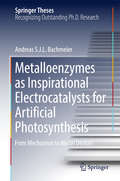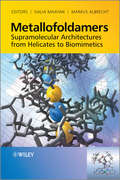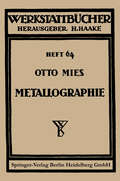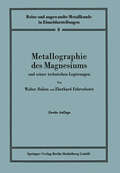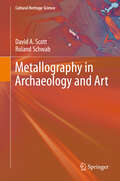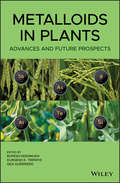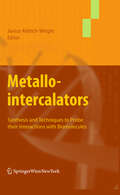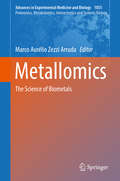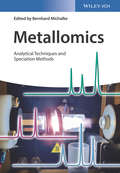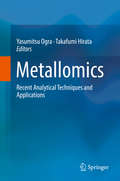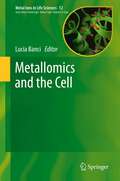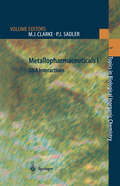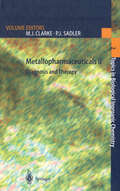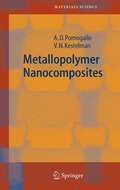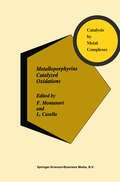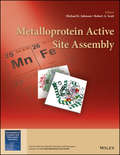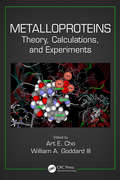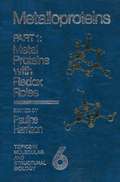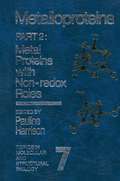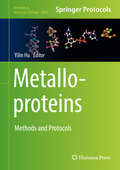- Table View
- List View
Metalloenzymes as Inspirational Electrocatalysts for Artificial Photosynthesis: From Mechanism to Model Devices (Springer Theses)
by Andreas S. BachmeierThis thesis describes a series of investigations designed to assess the value of metalloenzymes in systems for artificial and adapted photosynthesis. The research presented explores the interplay between inherent enzyme properties such as structure, rates and thermodynamics, and the properties of the semiconducting materials to which the enzyme is attached. Author, Andreas Bachmeier provides a comprehensive introduction to the interdisciplinary field of artificial photosynthesis, allowing the reader to grasp the latest approaches being investigated, from molecular systems to heterogeneous surface catalysis. Bachmeier’s work also uses metalloenzymes to highlight the importance of reversible catalysts in removing the burden of poor electrocatalytic rates and efficiencies which are common characteristics for most artificial photosynthesis systems. Overall, this thesis provides newcomers and students in the field with evidence that metalloenzymes can be used to establish new directions in artificial photosynthesis research.
Metallofoldamers: Supramolecular Architectures from Helicates to Biomimetics
by Galia Maayan Markus AlbrechtMetallofoldamers are oligomers that fold into three-dimensional structures in a controlled manner upon coordination with metal ions. Molecules in this class have shown an impressive ability to form single-handed helical structures and other three-dimensional architectures. Several metallofoldamers have been applied as sensors due to their selective folding when binding to a specific metal ion, while others show promise for applications as responsive materials on the basis of their ability to fold and unfold upon changes in the oxidation state of the coordinated metal ion, and as novel catalysts. Metallofoldamers: From Helicates to Biomimetic Architectures describes the variety of interactions between oligomers and metal species, with a focus on non-natural synthetic molecules. Topics covered include: the major classes of foldamers and their folding driving force metalloproteins and metalloenzymes helicates: self-assembly, structure and applications abiotic metallo-DNA metallo-PNA and iDNA metallopeptides interactions of biomimetic oligomers with metal ions applications of metallofoldamers
Metallofoldamers: Supramolecular Architectures from Helicates to Biomimetics
by Galia Maayan Markus AlbrechtMetallofoldamers are oligomers that fold into three-dimensional structures in a controlled manner upon coordination with metal ions. Molecules in this class have shown an impressive ability to form single-handed helical structures and other three-dimensional architectures. Several metallofoldamers have been applied as sensors due to their selective folding when binding to a specific metal ion, while others show promise for applications as responsive materials on the basis of their ability to fold and unfold upon changes in the oxidation state of the coordinated metal ion, and as novel catalysts. Metallofoldamers: From Helicates to Biomimetic Architectures describes the variety of interactions between oligomers and metal species, with a focus on non-natural synthetic molecules. Topics covered include: the major classes of foldamers and their folding driving force metalloproteins and metalloenzymes helicates: self-assembly, structure and applications abiotic metallo-DNA metallo-PNA and iDNA metallopeptides interactions of biomimetic oligomers with metal ions applications of metallofoldamers
Metallographie: Grundlagen und Anwendungen (Werkstattbücher #64 )
by Otto MiesDieser Buchtitel ist Teil des Digitalisierungsprojekts Springer Book Archives mit Publikationen, die seit den Anfängen des Verlags von 1842 erschienen sind. Der Verlag stellt mit diesem Archiv Quellen für die historische wie auch die disziplingeschichtliche Forschung zur Verfügung, die jeweils im historischen Kontext betrachtet werden müssen. Dieser Titel erschien in der Zeit vor 1945 und wird daher in seiner zeittypischen politisch-ideologischen Ausrichtung vom Verlag nicht beworben.
Metallographie des Magnesiums und seiner technischen Legierungen (Reine und angewandte Metallkunde in Einzeldarstellungen #8)
by Walter Bulian Eberhard FahrenhorstMetallography in Archaeology and Art (Cultural Heritage Science)
by David A. Scott Roland SchwabThis book provides a comprehensive introduction to the metallographic study of ancient metals. Metallography is important both conceptually as a microstructural science and in terms of its application to the study of ancient and historic metals. Metallography is a well-established methodology for the characterization of the microstructure of metals, which continues to be significant today in quality control and characterization of metallic properties. Not only does the metallographic examination of ancient metals present its own challenges in terms of sample size and interpretation of evidence, but it must be integrated with archaeological data and cultural research in order to obtain the most meaningful results. Issues of authentication and the establishment of fakes and forgeries of metallic artefacts often involve metallographic evidence of both metal and patina or corrosion interface, as an essential component of such a study. The present volume sets out the basic features of relevant metallic systems, enhanced with a series of examples of typical microstructural types, with illustrative case studies and examples throughout the text derived from studies undertaken by the two authors. This book provides a comprehensive presentation of metallography for archaeologists, archaeometallurgists, conservators, conservation scientists and metallurgists of modern materials.
Metalloids in Plants: Advances and Future Prospects
by Rupesh Deshmukh Gea Guerriero Durgesh Kumar TripathiUnderstanding metalloids and the potential impact they can have upon crop success or failure Metalloids have a complex relationship with plant life. Exhibiting a combination of metal and non-metal characteristics, this small group of elements – which includes boron (B), silicon (Si), germanium (Ge), arsenic (As), antimony (Sb), and tellurium (Te) – may hinder or enhance the growth and survival of crops. The causes underlying the effects that different metalloids may have upon certain plants range from genetic variance to anatomical factors, the complexities of which can pose a challenge to botanists and agriculturalists of all backgrounds. With Metalloids in Plants, a group of leading plant scientists present a complete guide to the beneficial and adverse impacts of metalloids at morphological, anatomical, biochemical, and molecular levels. Insightful analysis of data on genetic regulation helps to inform the optimization of farming, indicating how one may boost the uptake of beneficial metalloids and reduce the influence of toxic ones. Contained within this essential new text, there are: Expert analyses of the role of metalloids in plants, covering their benefits as well as their adverse effects Explanations of the physiological, biochemical, and genetic factors at play in plant uptake of metalloids Outlines of the breeding and genetic engineering techniques involved in the generation of resistant crops Written for students and professionals in the fields of agriculture, botany, molecular biology, and biotechnology, Metalloids in Plants is an invaluable overview of the relationship between crops and these unusual elements.
Metalloids in Plants: Advances and Future Prospects
by Rupesh Deshmukh Durgesh K. Tripathi Gea GuerrieroUnderstanding metalloids and the potential impact they can have upon crop success or failure Metalloids have a complex relationship with plant life. Exhibiting a combination of metal and non-metal characteristics, this small group of elements – which includes boron (B), silicon (Si), germanium (Ge), arsenic (As), antimony (Sb), and tellurium (Te) – may hinder or enhance the growth and survival of crops. The causes underlying the effects that different metalloids may have upon certain plants range from genetic variance to anatomical factors, the complexities of which can pose a challenge to botanists and agriculturalists of all backgrounds. With Metalloids in Plants, a group of leading plant scientists present a complete guide to the beneficial and adverse impacts of metalloids at morphological, anatomical, biochemical, and molecular levels. Insightful analysis of data on genetic regulation helps to inform the optimization of farming, indicating how one may boost the uptake of beneficial metalloids and reduce the influence of toxic ones. Contained within this essential new text, there are: Expert analyses of the role of metalloids in plants, covering their benefits as well as their adverse effects Explanations of the physiological, biochemical, and genetic factors at play in plant uptake of metalloids Outlines of the breeding and genetic engineering techniques involved in the generation of resistant crops Written for students and professionals in the fields of agriculture, botany, molecular biology, and biotechnology, Metalloids in Plants is an invaluable overview of the relationship between crops and these unusual elements.
Metallointercalators: Synthesis and Techniques to Probe Their Interactions with Biomolecules
by Janice Aldrich-WrightA comprehensive treatment of the characterisation techniques used in investigating inorganic and organic molecules that interact with biomolecules is presented to the reader in a clear fashion. The work consists of two parts: (i) synthetic aspects of metallointercalators along with targeting and improving transport and (ii) the various techniques that are used for probing their interactions, such as; DNA-NMR, PGSE-NMR, DNA ESI-MS, Linear and Circular Dichroism, Fluorescence Spectroscopy, Confocal Microscopy, Viscosity, TGA and dialysis, Microarrays, biological analysis. Chapters are devoted to the synthesis and the techniques used to study the interactions of inorganic complexes with biomolecules. Considerably detailed examples are used to help illustrate the application of these techniques. This book is a useful resource for an array of inorganic and organic advanced undergraduate and graduate courses and for researchers in drug discovery.
Metallomics: The Science of Biometals (Advances in Experimental Medicine and Biology #1055)
by Marco Aurélio ArrudaThis book covers the new Omics area, Metallomics. As Metallomics is intrinsically a transdisciplinary area, this book is authored by experts in the field on such diverse topics as Environmental, Nuclear, and Human Metallomics. Within these topics metals play important role, as being part of biomolecules, controlling different biochemical process, being signaling agents, being catalyst of biochemical reactions, among others. This volume demonstrates the importance of more investigation about metals and their interactions with biomolecules. As the knowledge in this field is growing and growing daily, then new challenges concerning studies involving Metallomics is appearing, such as comparative metallomics, speciation metallomics, real-time metallomics, new predictions of metals in biomolecules, metalloprotein databank expansion, interactions between metalloprotein-metalloprotein, among others.
Metallomics: Analytical Techniques and Speciation Methods
by Bernhard MichalkeLatest developments, new insights and knowledge derived from speciation analysis in one unique compilation: The reader gets acquainted with relevant instrumental as well as application aspects of metallomics approaches, paving the road to understanding fate, pathway, and action of metals in environment and organisms. Upon an introductory chapter on analytical methods and strategies, the full bandwidth of applications is discussed. Expert chapter authors cast spotlights on recent topics such as metallomics applications to environmental and nutrition studies as well as biology and medicine. Special chapters deal with the impact of manganese and iron on neurodegeneration, and the impact of nanoparticles on health.
Metallomics: Analytical Techniques and Speciation Methods
by Bernhard MichalkeLatest developments, new insights and knowledge derived from speciation analysis in one unique compilation: The reader gets acquainted with relevant instrumental as well as application aspects of metallomics approaches, paving the road to understanding fate, pathway, and action of metals in environment and organisms. Upon an introductory chapter on analytical methods and strategies, the full bandwidth of applications is discussed. Expert chapter authors cast spotlights on recent topics such as metallomics applications to environmental and nutrition studies as well as biology and medicine. Special chapters deal with the impact of manganese and iron on neurodegeneration, and the impact of nanoparticles on health.
Metallomics: Recent Analytical Techniques and Applications
by Yasumitsu Ogra Takafumi HirataThis book focuses on recent topics in metallomics, a study of the metallome, or metal-containing biomolecules. Metals can induce various physiological and toxicological effects in a very small amounts, in other words, the concentrations of biometals are very low in organisms. Thus, analytical techniques for a trace amount of metal are crucial to understand the biological and toxicological functions of metals.This volume begins with an overview of metallomics including the history and development of the field. Subsequent parts provide basic and advanced techniques for metallomics. Speciation and imaging of metals are basic approaches to reveal the function of the metallome. The applications of speciation using an HPLC hyphenated with inductively coupled plasma mass spectrometry (LC-ICP-MS) and flow cytometry ICP-MS are described. As advanced approaches, the applications using a micro-flow injection-ICP-MS, an ICP-triple quadrupole mass spectrometer, an ICP-sector field mass spectrometer, and an ICP-multi-collector mass spectrometer are mentioned. For the imaging of metals, basic principles and applications of several techniques such as scanning X-ray fluorescence microscopy and ICP-MS equipped with laser ablation (LA-ICP-MS) are presented. Speciation analyses using electrospray ionization mass spectrometry (ESI-MS), X-ray Absorption Spectroscopy (XAS), and nuclear magnetic resonance spectroscopy (NMR) are also introduced. The last part highlights the medical and pharmaceutical applications of metallomics. Molecular biological approaches to reveal the effects of toxic metals, metal functions in brain and neurodegenerative diseases, and metallodrugs are explained. The topic of metal transporters is also presented.
Metallomics and the Cell (Metal Ions in Life Sciences #12)
by Lucia BanciMetallomics and the Cell provides in an authoritative and timely manner in 16 stimulating chapters, written by 37 internationally recognized experts from 9 nations, and supported by more than 3000 references, several tables, and 110 illustrations, mostly in color, a most up-to-date view of the "metallomes" which, as defined in the "omics" world, describe the entire set of biomolecules that interact with or are affected by each metal ion. The most relevant tools for visualizing metal ions in the cell and the most suitable bioinformatic tools for browsing genomes to identify metal-binding proteins are also presented. Thus, MILS-12 is of relevance for structural and systems biology, inorganic biological chemistry, genetics, medicine, diagnostics, as well as teaching, etc.
Metallopharmaceuticals I: DNA Interactions (Topics in Biological Inorganic Chemistry #1)
by Professor Michael J. ClarkeEach volume provides the reader, whether engaged in chemistry, biochemistry, biology or molecular medicine, with a comprehensive summary and critical overview of a topic of great current interest written by leading international experts.
Metallopharmaceuticals II: Diagnosis and Therapy (Topics in Biological Inorganic Chemistry #2)
by Michael J. Clarke Peter J. SadlerBiological inorganic chemistry is a field of research at the interface of inorganic and biological chemistry. The rapidly developing insights into the role of metals in biological systems has far-reaching implications not only for biological science but also for related disciplines, ranging from molecular medicine to the environment. In each volume the reader, whether engaged in chemistry, biochemistry, biology or molecular medicine, receives a comprehensive summary and critical overview of a topic of hight current interest written by leading international experts.
Metallopolymer Nanocomposites (Springer Series in Materials Science #81)
by A.D. Pomogailo V.N. KestelmanThis book presents and analyzes the essential data on nanoscale metal clusters dispersed in, or chemically bonded with polymers. Special attention is paid to the in situ synthesis of the nanocomposites, their chemical interactions, and the size and distribution of the particles in the polymer matrix. Numerous novel nanocomposites are described with regard to their mechanical, electrophysical, optical, magnetic, catalytic and biological properties. Their applications, present and future, are outlined.
Metalloporphyrins Catalyzed Oxidations (Catalysis by Metal Complexes #17)
by F. Montanari L. CasellaOxidative catalysis by metalloporphyrin systems occupies a prominent role in the current research in the fields of chemical and biological catalysis. Our particular interest and approach has been to collect in the same volume papers dealing with both the chemical and biological aspects of the reactivity of heme systems because of the realization that a better understanding of the complementary discipline can be extremely useful for the researchers from either field. The current progress of the research on synthetic metalloporphyrin catalysts has led to the development of several systems that are able to reproduce the heme-enzyme mediated oxygenation and oxidation reactions, at least in terms of reaction types, mechanisms and often rates. These achievements have stimulated the of creating metalloporphyrin catalysts which are both ambitious project efficient and stable enough to become competitive for large-scale industrial processes. Although this project is still far from being realized, the efforts in this direction parallel those aimed at the application of heme enzymes to chemical technologies, e. g. for the mild, selective oxidation of organics or the detoxification of pollutants. Both the two approaches will be advantageous because while the enzyme systems can achieve selectivities which are probably unattainable by synthetic catalysts, the latter can be active under experimental conditions that would readily inactivate the enzymes.
Metalloprotein Active Site Assembly (EIC Books)
by Michael K. Johnson Robert A. ScottSummarizes the essential biosynthetic pathways for assembly of metal cofactor sites in functional metalloproteins Metalloprotein Active Site Assembly focuses on the processes that have evolved to orchestrate the assembly of metal cofactor sites in functional metalloproteins. It goes beyond the simple incorporation of single metal ions in a protein framework, and includes metal cluster assembly, metal-cofactor biosynthesis and insertion, and metal-based post-translational modifications of the protein environments that are necessary for function. Several examples of each of these areas have now been identified and studied; the current volume provides the current state-of-the-art understanding of the processes involved. An excellent companion to the earlier book in this series Metals in Cells—which discussed both the positive and negative effects of cellular interactions with metals—this comprehensive book provides a diverse sampling of what is known about metalloprotein active site assembly processes. It covers all major biological transition metal components (Mn, Fe, Co, Ni, Mo), as well as the other inorganic components, metal-binding organic cofactors (e.g., heme, siroheme, cobalamin, molybdopterin), and post-translationally modified metal binding sites that make up the patchwork of evolved biological catalytic sites. The book compares and contrasts the biosynthetic assembly of active sites involving all biological metals. This has never been done before since it is a relatively new, fast-developing area of research. Metalloprotein Active Site Assembly is an ideal text for practitioners of inorganic biochemistry who are studying the biosynthetic pathways and gene clusters involved in active site assembly, and for inorganic chemists who want to apply the concepts learned to potential synthetic pathways to active site mimics.
Metalloprotein Active Site Assembly (EIC Books)
by Michael K. Johnson Robert A. ScottSummarizes the essential biosynthetic pathways for assembly of metal cofactor sites in functional metalloproteins Metalloprotein Active Site Assembly focuses on the processes that have evolved to orchestrate the assembly of metal cofactor sites in functional metalloproteins. It goes beyond the simple incorporation of single metal ions in a protein framework, and includes metal cluster assembly, metal-cofactor biosynthesis and insertion, and metal-based post-translational modifications of the protein environments that are necessary for function. Several examples of each of these areas have now been identified and studied; the current volume provides the current state-of-the-art understanding of the processes involved. An excellent companion to the earlier book in this series Metals in Cells—which discussed both the positive and negative effects of cellular interactions with metals—this comprehensive book provides a diverse sampling of what is known about metalloprotein active site assembly processes. It covers all major biological transition metal components (Mn, Fe, Co, Ni, Mo), as well as the other inorganic components, metal-binding organic cofactors (e.g., heme, siroheme, cobalamin, molybdopterin), and post-translationally modified metal binding sites that make up the patchwork of evolved biological catalytic sites. The book compares and contrasts the biosynthetic assembly of active sites involving all biological metals. This has never been done before since it is a relatively new, fast-developing area of research. Metalloprotein Active Site Assembly is an ideal text for practitioners of inorganic biochemistry who are studying the biosynthetic pathways and gene clusters involved in active site assembly, and for inorganic chemists who want to apply the concepts learned to potential synthetic pathways to active site mimics.
Metalloproteins: Theory, Calculations, and Experiments
by Art E. Cho William A. Goddard IIINumerous essential biological functions involve metalloproteins; therefore, understanding metalloproteins and how to manipulate them is significant in the biological and medical fields. An examination of current research, Metalloproteins: Theory, Calculations, and Experiments explores the interplay between theory and experiment, detailing the role
Metalloproteins: Theory, Calculations, and Experiments
by Art E. Cho William A. Goddard IIINumerous essential biological functions involve metalloproteins; therefore, understanding metalloproteins and how to manipulate them is significant in the biological and medical fields. An examination of current research, Metalloproteins: Theory, Calculations, and Experiments explores the interplay between theory and experiment, detailing the role
Metalloproteins: Part 1: Metal Proteins with Redox Roles (Topics in Molecular and Structural Biology)
by P.M. HarrisonMetalloproteins: Metal Proteins with Non-Redox Roles (Topics in Molecular and Structural Biology)
by P.M. HarrisonMetalloproteins: Methods and Protocols (Methods in Molecular Biology #1876)
by Yilin HuThis volume provides an up-to-date, in-depth overview of the methods that have been applied to studying the complex metalloproteins at a molecular level. Chapters cover a wide range of approaches focusing on genetic, biochemical, spectroscopic, chemical methods, and theoretical calculations. Written in the highly successful Methods in Molecular Biology series format, chapters include introductions to their respective topics, lists of the necessary materials and reagents, step-by-step, readily reproducible laboratory protocols, and tips on troubleshooting and avoiding known pitfalls. Authoritative and cutting-edge, Metalloproteins: Methods and Protocols aims to be useful for anyone who is interested in metalloprotein research and wants to address the unanswered mechanistic and biosynthetic questions of these fascinating enzyme systems.
